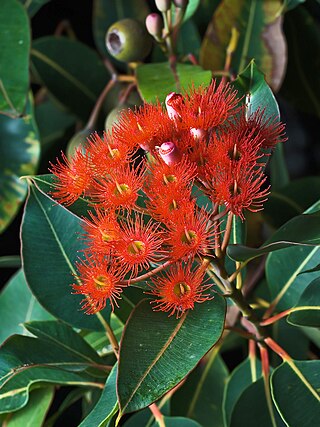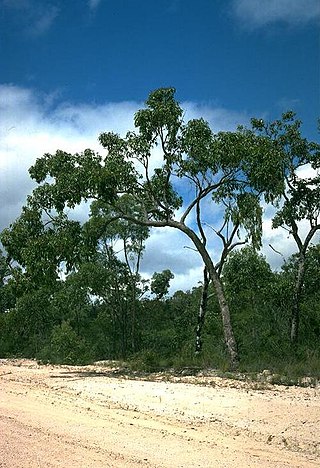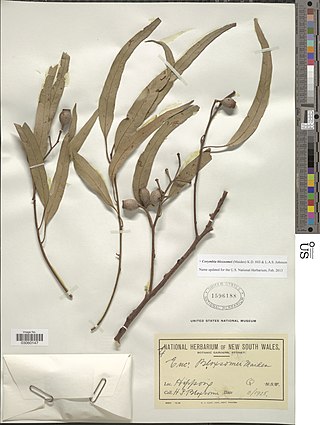
Corymbia ficifolia, commonly known as red flowering gum, is a species of small tree that is endemic to the south-west of Western Australia. It has rough, fibrous bark on the trunk and branches, egg-shaped to broadly lance-shape adult leaves, flower buds in groups of seven, bright red, pink or orange flowers and urn-shaped fruit. It has a restricted distribution in the wild but is one of the most commonly planted ornamental eucalypts.

Corymbia abergiana, commonly known as range bloodwood or Rockingham Bay bloodwood, is a species of tree that is endemic to Queensland. It has rough bark on the trunk and larger branches, smooth bark on the smaller branches, lance-shaped adult leaves, flower buds in groups of seven, creamy white flowers and barrel-shaped fruit with a very thick rim.

Corymbia opaca, also known as desert bloodwood, is a species of tree that is endemic to northern Australia. It has rough bark on part or all of the trunk, lance-shaped leaves, club-shaped flower buds and urn-shaped fruit. Several parts of this plant are used by Aboriginal Australians in traditional medicine.

Corymbia tessellaris, commonly known as carbeen or Moreton Bay ash, is a species of tree that is endemic to north-eastern Australia. It has rough, tessellated bark on the lower trunk abruptly changing to smooth, whitish bark above, narrow lance-shaped adult leaves, flower buds in groups of three or seven, white flowers and cylindrical or urn-shaped fruit

Corymbia terminalis, also known as tjuta, joolta, bloodwood, desert bloodwood, plains bloodwood, northern bloodwood, western bloodwood or inland bloodwood, is a species of small to medium-sized tree, rarely a mallee that is endemic to Australia. It has rough, tessellated bark on some or all of the trunk, sometimes also on the larger branches, smooth white to cream-coloured bark above, lance-shaped adult leaves, flower buds in groups of seven, white flowers and urn-shaped fruit.

Corymbia ptychocarpa, commonly known as swamp bloodwood or spring bloodwood, is a species of tree that is endemic to northwestern Australia. It has rough bark on the trunk and branches, broadly lance-shaped adult leaves, flower buds in groups of seven, creamy yellow, pink or red flowers, and barrel-shaped, ribbed fruit.
Corymbia greeniana is a species of tree that is endemic to northern Australia. It has rough bark on some or all of the trunk and larger branches, smooth bark above, broadly lance-shaped to egg-shaped adult leaves, flower buds usually in groups of seven, creamy white flowers and urn-shaped fruit with a distinct neck.

Corymbia collina, commonly known as silver-leaved bloodwood, is a species of tree that is endemic to Western Australia. It has thin patchy rough bark on some or all of the trunk, smooth white to pale grey bark above, lance-shaped to curved adult leaves, flower buds in groups of seven, creamy white flowers and barrel-shaped fruit.

Corymbia eremaea, commonly known as mallee bloodwood, hill bloodwood and Centre Range bloodwood, is a small, mallee-like tree that is endemic to central Australia. Indigenous Australians know the plant as muur-muurpa. It has rough, evenly tessellated bark, lance-shaped leaves, oval to pear-shaped flower buds arranged on a branching peduncle and urn-shaped fruit.

Corymbia foelscheana, commonly known as broad-leaved bloodwood, fan-leaved bloodwood or smooth-barked bloodwood, is a species of small tree that is endemic to northern Australia. It has thin, rough, tessellated bark on some or all of the trunk, smooth bark above, broadly egg-shaped to broadly lance- shaped adult leaves, flower buds usually in groups of seven, creamy white flowers and urn-shaped fruit.
Corymbia hamersleyana is a species of small tree or mallee that is endemic to the Pilbara region of Western Australia. It has rough, flaky bark on part or all of the trunk, smooth cream-coloured bark above, lance-shaped adult leaves, flowers buds in groups of seven or nine, creamy white flowers and urn-shaped fruit.

Corymbia clarksoniana, commonly known as Clarkson's bloodwood or grey bloodwood, is a species of medium-sized tree that is native to Queensland and northern New South Wales. It has rough, tessellated greyish to brownish bark on the trunk and branches, lance-shaped, glossy green leaves that are paler on the lower surface, flower buds in groups of seven, white flowers and urn-shaped to barrel-shaped fruit.

Corymbia bloxsomei, commonly known as yellowjack, yellow jacket or yellow bloodwood, is a species of tree that is endemic to inland, south-eastern Queensland. It has thick, rough scaly bark on the trunk and larger branches, lance-shaped or curved adult leaves, flower buds in groups of seven, nine or eleven, creamy white to pale yellow flowers and barrel-shaped, urn-shaped or spherical fruit.
Corymbia clandestina, commonly known as Drummond Range bloodwood, is a species of small tree that is endemic to Queensland. It has rough, tessellated bark on the trunk and branches, lance-shaped adult leaves, flower buds in groups of seven, white flowers and urn-shaped to barrel-shaped fruit.

Corymbia kombolgiensis, commonly known as scarp gum or paper-fruited bloodwood, is a species of small tree that is endemic to the Northern Territory. It has smooth bark, sometimes with rough, tessellated bark near the base, linear to narrow lance-shaped adult leaves, flower buds usually in groups of seven, white flowers and cylindrical to barrel-shaped fruit.
Corymbia polysciada, commonly known as apple gum, paper-fruited bloodwood or bolomin, is a species of tree that is endemic to the Top End of the Northern Territory. It has rough, tessellated bark on some or all or the trunk, smooth bark above, egg-shaped to broadly lance-shaped adult leaves, flower buds in groups of seven, creamy white flowers and cup-shaped, cylindrical or barrel-shaped from on long pedicels.
Corymbia rhodops, commonly known as red-throated bloodwood, is a species of tree that is endemic to Queensland. It has rough, tessellated bark on the trunk and larger branches, lance-shaped adult leaves, flower buds in groups of seven, creamy white flowers with a red centre, and urn-shaped to barrel-shaped fruit.

Corymbia umbonata, commonly known as rusty bloodwood, is a species of tree that is endemic to the Top End of the Northern Territory. It has thin, rough bark on the trunk, often also the branches, lance-shaped or curved adult leaves, flower buds in groups of seven, creamy white flowers and urn-shaped fruit.

Corymbia watsoniana, commonly known as large-fruited yellowjacket, is a species of tree that is endemic to Queensland. It has rough, tessellated bark on the trunk and branches, egg-shaped to broadly lance-shaped adult leaves, flower buds in groups of seven, creamy white flowers and barrel-shaped or urn-shaped fruit.
Corymbia novoguinensis is a species of tree that is native to New Guinea, some Torres Strait Island and the Cape York Peninsula. It has rough bark on the trunk and branches, lance-shaped adult leaves, flower buds in groups of seven, creamy white flowers and urn-shaped to barrel-shaped fruit.


















